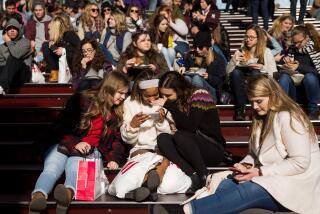Children Say Media Give Negative View of Youth : Images: First study of its kind finds that young people depend on news shows and newspapers for information. But most come away feeling angry or sad.
- Share via
SAN FRANCISCO — Most children who watch television news or read newspapers believe the media portray a negative image of young people that emphasizes violence, drugs and crime, according to a nationwide poll released Monday.
In a survey of 850 children ages 11 through 16--the first study of its kind--most youngsters said the media do not do a good job of covering issues important to them and that they feel “angry, sad or depressed” after watching or reading the news.
Children Now, an advocacy group that sponsored the poll, said the survey shows that young people have faith in the media and rely on them for information, but often feel the news does not reflect the truth of their daily lives.
“Millions of children see almost exclusively negative images of kids their age in the news every day,” said James P. Steyer, president of Children Now. “This alone can directly affect their behavior.”
The study, conducted by telephone in late January, concluded that children are eager for positive news about members of their generation, with 44% saying they would like the media to give more coverage to children “doing good things,” “staying away from trouble” or “helping the environment.”
At the same time, nearly two-thirds of the children polled agreed with the statement: “If it wasn’t for the news media, people would do a lot less to help kids in trouble or fight violence against children.”
The adults who sponsored the poll said they were surprised to find that youngsters follow the news closely and take it seriously. Of those surveyed, 65% said they had watched a news program and 44% said they had read a newspaper the previous day.
“These kids are plugged into the news,” said pollster Paul Maslin, who helped conduct the survey. “That is perhaps the most surprising thing for us.”
Four out of five children surveyed said the media are fair and believe what they see and read. But by the same margin, they also say their point of view is seldom represented.
“I think they (the media) basically tell the truth,” said Liam Carey, 13, a San Francisco eighth-grader who was one of three children helping to present the survey findings at a news conference. “They just don’t tell everything that goes on. They don’t tell kids’ perspectives.”
The survey found the highest degree of alienation among African Americans and Latinos, with girls far more dismayed by the media than boys were.
Nearly three-fourths of the African American children and about two-thirds of the Latino children said the only time members of their group were portrayed in the news was in connection with crime, violence or drugs. By comparison, half the white children surveyed held that view.
At the same time, 66% of the girls polled said they felt angry after watching, reading or listening to the news, compared to 46% of the boys. And 62% of the girls said they felt sad or depressed by the news, compared to 40% of boys.
Steyer said the high level of violence in news about children makes many young viewers afraid, can damage their self-esteem and inspire some to act out more aggressively.
“If they believe what they read or see and they take it as true, it has a bigger impact on their self-image,” he said. “It may increase their use of violence. It may legitimize violence.”
The children’s view that violence dominates news about their generation is supported by academics at UC Santa Barbara who studied the three network evening news shows and five major newspapers, including The Times.
That study, also released Monday, showed that 48% of television stories and 40% of newspaper stories about children over a monthlong period involved crime and violence. During the same month, only 3% of the television stories and 4% of the newspaper stories about children touched on poverty, and even fewer dealt with the issues of child care or health care for children.
Decrying the lack of attention to children’s economic troubles, Steyer said: “Today, there are 14 million children who live below the poverty line and nearly twice that many just above the poverty line. Children are the poorest group in America.”
The survey of children also contained a bit of bad news for newspaper publishers concerned with their future readership: Overall, 44% of the children said television news did the best job of covering issues important to them, while 28% said daytime talk shows did the best job. Only 23% said newspapers did the best job.
More to Read
Sign up for Essential California
The most important California stories and recommendations in your inbox every morning.
You may occasionally receive promotional content from the Los Angeles Times.












